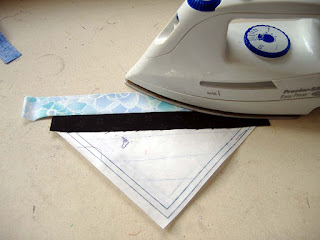Inspiration for this
block came from Elizabeth Hartman’s book, The Practical Guide to Patchwork. The
quilt she shows in this book is called Valentine. There are numerous differences, but I don’t
claim what I am presenting here as original.
To start with, I prefer
to freezer paper piece. I used Word to
create a 6.5 inch box, inside of which I put a 6 inch box. I drew diagonal lines either side of the
center diagonal. This is the starting
strip. Hartman then has you adlib the
remaining strips, but since this block is part of a virtual bee, I decided to
preordain the strips and continued drawing them in – 5 strips on one side of the
middle strip and four on the other. You can chose to have a few or as many as
you want. The template for this block is
available as a PDF file via Google documents. I printed the template onto freezer
paper. The following instructions are for using it to foundation piece each
quarter.
To create the full block,
you will make four quarter blocks. The middle strip will be the same color in
all blocks (labeled BG on the template).
I chose black.
Since this is the
tutorial for a blue themed bee, lay out five fabrics that range from light blue
to dark blue and cut them into strips of the appropriate length and width to exceed
the corresponding strip on the template by at least ¼ inch on each side. See picture below.
Cut the middle black
strip long enough to go a little beyond both ends of the drawn strip and wide
enough so that at least ¼ inch of the
strip extends beyond the drawn sides.
Place the strip face down. Place
the template wax side down over the strip so you can see it beyond all the
lines. Iron it down to the strip.
Fold back along the line on
the side that has five strips and trim the fabric that shows to ¼ inch, if
needed. Take the lightest blue strip and
put it right sides together with the black strip. Place this under your sewing machine needle,
with the folded back freezer paper on top.
Sew with the needle as close as you can to the fold, but do not sew
through the paper. ( Next 2 pictures)
Fold the light blue strip
out and iron on the right side (freezer paper is still folded back). This ensures you have a crisp, tight
seam. Flip over to the wrong side, fold
the template over the fabric and iron down. Next 2 pictures.
Now fold the template
back along the second line. Trim the
exposed fabric to ¼ inch, as needed.
Take the second strip, right sides together with the strip just sewn on
and once again sew right along the folded template edge. Press the new strip out, flip over, iron down
the template. Fold back the third
line. Repeat until you have filled the
template on the five strip side.
Now do the same thing
with the four strip side, making sure you add the lightest value blue strip to
the center and go darker as you proceed to the corner. If for some reason one of your strips isn't quite right for the drawn strip, there's no problem changing the width of that strip - as long as you end up correctly at the corner. I did that with one strip I had cut a bit too narrow.
When the template is
full, trim just a bit outside the drawn ¼ seam allowance line. Freezer paper does shrink and no matter
carefully you remove it, the block will distort a little.
After this trimming, carefully peel the
freezer paper back, starting at one of the black strip corner and pulling
parallel with the seam lines. Starch and
iron the heck out of the quarter block and then trim it to 6 ½ inches square.
Create all four quarters
this way – the template can be reused, although it may not be as sticky and may
require a bit more ironing. I have used
templates up to 8 times.
Once you have the four
quarters completed, spend a little time arranging them to find the most
pleasing one. Sew the quarters into one
block, matching the black strip as best as possible and the center seams,
too. Starch and press before trimming to
12 ½ inches.
Below is what two blocks
together look like. They aren't sewn together yet - I would want the match the black lattice better possible to create a stained glass look. I am looking forward
to seeing all the blocks together – I think this will look really cool!










2 comments:
This is a great explanation!
Just awarded you!
http://creativeinspiraciones.blogspot.com/
Post a Comment